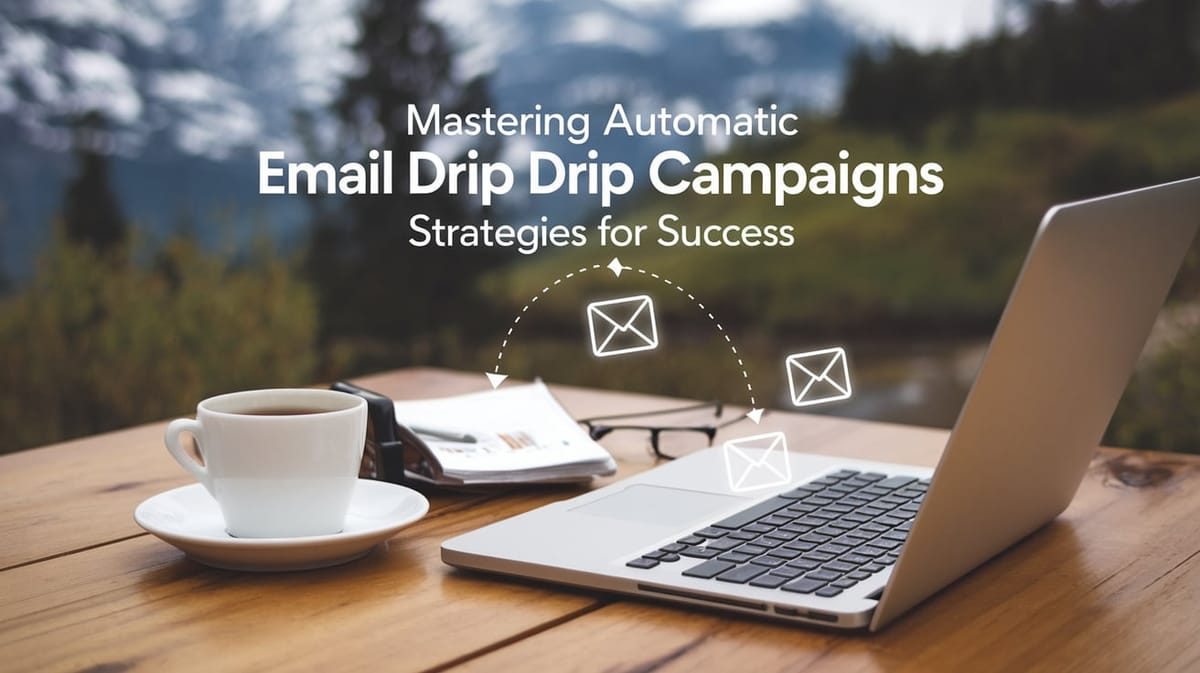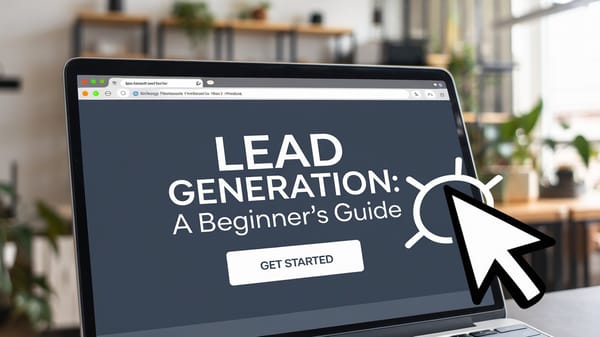Mastering Automatic Email Drip Campaigns: Strategies for Success
"Unlocking Engagement: How Email Drip Campaigns Transform Leads into Loyal Customers"

In the ever-evolving landscape of digital marketing, email drip campaigns have emerged as a powerful tool for nurturing leads and driving conversions. These campaigns, characterized by their automated, personalized, and contextually relevant content, allow marketers to engage with their audience at precisely the right moments. By leveraging automation, businesses can deliver a series of pre-planned emails triggered by specific actions or behaviors, ensuring that each message is timely and relevant.
An email drip campaign is an automated marketing strategy that involves sending a sequence of emails to a lead over a set period. This approach is particularly effective in maintaining long-term relationships with customers, as it provides a steady stream of communication that can guide potential buyers through the sales funnel. According to HubSpot's 2024 State of Marketing Report, 87% of marketers plan to increase their investment in email marketing, underscoring the importance of this channel in modern marketing strategies.
The success of an email drip campaign hinges on strategic planning and the use of robust email automation tools. These tools enable marketers to automate the scheduling and sending of emails, integrate with CRM systems, and personalize content to suit the needs of each recipient. By doing so, businesses can create empathetic yet compelling campaigns that resonate with their audience.
Moreover, email drip campaigns are not limited to sales-oriented messages. They can be used to reduce cart abandonment rates, convert blog visitors into buyers, re-engage inactive customers, or simply welcome new subscribers. The versatility of these campaigns makes them an invaluable asset for both B2B and B2C brands, as they can be tailored to address various stages of the buyer's journey.
You can also visit Oncely.com to find more Top Trending AI Tools. Oncely partners with software developers and companies to present exclusive deals on their products. One unique aspect of Oncely is its “Lifetime Access” feature, where customers can purchase a product once and gain ongoing access to it without any recurring fees. Oncely also provides a 60-day money-back guarantee on most purchases, allowing customers to try out the products and services risk-free.
Oncely are hunting for the most fantastic AI & Software lifetime deals like the ones below or their alternatives:

Understanding Email Drip Campaigns
Definition and Purpose of Email Drip Campaigns
Email drip campaigns are a series of automated emails sent to subscribers based on specific timelines or user actions. These campaigns are designed to nurture leads, engage customers, and drive conversions by delivering the right message at the right time. The primary purpose of drip campaigns is to maintain consistent communication with the audience, ensuring that they receive relevant content that aligns with their interests and behaviors. According to a study by Campaign Monitor, businesses that use drip campaigns see an average increase in sales of 20%.
Key Components of Effective Drip Campaigns
- Segmentation and Targeting: Segmentation is crucial for the success of drip campaigns. By dividing the email list into smaller, more targeted groups based on demographics, behavior, or engagement level, marketers can tailor messages to meet the specific needs of each segment. According to Mailchimp, segmented campaigns can result in a 14.31% higher open rate compared to non-segmented campaigns.
- Personalization: Personalization goes beyond using the recipient's name in the email. It involves customizing the content based on the recipient's past interactions, preferences, and purchase history. A report by Experian indicates that personalized emails deliver six times higher transaction rates.
- Timing and Frequency: The timing and frequency of emails in a drip campaign are critical factors that influence engagement. Emails should be sent at intervals that align with the customer journey and the specific goals of the campaign. For instance, a welcome series might send emails more frequently at the beginning and then taper off. Research from GetResponse suggests that the best days to send emails are Tuesday and Thursday, with optimal open rates occurring between 10 AM and 2 PM.
- Content and Messaging: The content of each email should be relevant, valuable, and aligned with the campaign's objectives. This includes a clear call-to-action (CTA) that guides the recipient towards the desired action, whether it's making a purchase, signing up for a webinar, or downloading a resource. According to HubSpot, emails with a single CTA can increase clicks by 371% and sales by 161%.
- Automation Tools and Platforms: Utilizing the right automation tools is essential for managing and executing drip campaigns efficiently. Platforms like ActiveCampaign and Klaviyo offer robust features for creating, scheduling, and analyzing drip campaigns. These tools provide insights into open rates, click-through rates, and conversion metrics, enabling marketers to optimize their strategies.
Benefits of Email Drip Campaigns
Email drip campaigns offer several benefits that contribute to their effectiveness in digital marketing strategies:
- Increased Engagement: By delivering timely and relevant content, drip campaigns keep subscribers engaged over time. This sustained engagement can lead to higher open and click-through rates, as evidenced by Litmus which reports that automated emails generate 320% more revenue than non-automated emails.
- Lead Nurturing: Drip campaigns are particularly effective for nurturing leads through the sales funnel. By providing valuable information and addressing potential objections, these campaigns can move prospects closer to making a purchase decision. According to Forrester Research, companies that excel at lead nurturing generate 50% more sales-ready leads at a 33% lower cost.
- Customer Retention: Drip campaigns can also play a significant role in customer retention by maintaining ongoing communication and offering post-purchase support. This can lead to increased customer loyalty and repeat business. A study by Invesp found that increasing customer retention rates by 5% can increase profits by 25% to 95%.
Challenges and Considerations
While email drip campaigns offer numerous advantages, there are challenges and considerations that marketers must address to ensure their success:
- Deliverability Issues: Ensuring that emails reach the inbox and not the spam folder is a common challenge. Marketers must adhere to best practices for email deliverability, such as maintaining a clean email list and avoiding spammy language. Return Path reports that 21% of opt-in emails fail to reach the inbox.
- Content Fatigue: Sending too many emails or irrelevant content can lead to subscriber fatigue and increased unsubscribe rates. It's important to monitor engagement metrics and adjust the frequency and content of emails accordingly. MarketingSherpa suggests that 25% of subscribers will unsubscribe if they receive too many emails.
- Data Privacy and Compliance: With regulations like GDPR and CCPA, marketers must ensure that their drip campaigns comply with data privacy laws. This includes obtaining explicit consent from subscribers and providing easy opt-out options. Non-compliance can result in hefty fines and damage to brand reputation, as highlighted by Deloitte.
Measuring Success and Optimization
To maximize the effectiveness of email drip campaigns, marketers must continuously measure and optimize their strategies. Key performance indicators (KPIs) such as open rates, click-through rates, conversion rates, and unsubscribe rates provide valuable insights into campaign performance. Tools like Google Analytics and Mailchimp offer detailed analytics to track these metrics.
A/B testing is another critical component of optimization, allowing marketers to test different subject lines, content formats, and CTAs to determine what resonates best with their audience. According to Optimizely, A/B testing can improve conversion rates by up to 49%.
Setting Up Automated Email Drip Campaigns
Planning and Strategy Development
Setting up an automated email drip campaign begins with a comprehensive planning and strategy development phase. This phase involves defining the campaign's objectives, identifying the target audience, and determining the type of content that will be most effective. According to a 2023 report by HubSpot, 78% of marketers have seen an increase in email engagement over the past year, highlighting the importance of strategic planning in email marketing.
- Defining Objectives: The primary goal of an email drip campaign is to nurture leads through the sales funnel by delivering timely and relevant content. Objectives can range from increasing brand awareness to driving conversions or retaining customers. Clearly defined objectives help in measuring the campaign's success and optimizing future efforts.
- Identifying Target Audience: Segmentation is crucial in email marketing. By dividing the audience into specific groups based on demographics, behavior, or engagement levels, marketers can tailor messages to meet the unique needs of each segment. According to Mailchimp, segmented campaigns can result in a 14.31% higher open rate compared to non-segmented campaigns.
- Content Strategy: The content of a drip campaign should be aligned with the buyer's journey. For instance, educational content is suitable for the awareness stage, while product comparisons and testimonials are more effective during the consideration stage. A study by Campaign Monitor found that personalized content can increase click-through rates by 14% and conversion rates by 10%.
Selecting the Right Tools and Platforms
Choosing the appropriate tools and platforms is essential for the successful implementation of an automated email drip campaign. The right software can streamline the process, enhance personalization, and provide valuable insights through analytics.
- Email Marketing Platforms: Platforms like Mailchimp, HubSpot, and ActiveCampaign offer robust features for creating and managing drip campaigns. These platforms provide automation capabilities, segmentation options, and analytics to track performance.
- Integration with CRM Systems: Integrating email marketing platforms with Customer Relationship Management (CRM) systems like Salesforce or Zoho CRM allows for seamless data flow and enhances the ability to personalize content based on customer interactions and history.
- Automation Features: Automation features such as triggers, workflows, and scheduling are critical for drip campaigns. Triggers can be set based on user actions, such as signing up for a newsletter or abandoning a cart, to initiate a series of automated emails. According to Litmus, 82% of companies use email automation to improve their marketing efforts.
Designing and Crafting Email Content
The design and content of emails play a significant role in the effectiveness of a drip campaign. Emails should be visually appealing, easy to read, and contain compelling calls-to-action (CTAs).
- Email Design: A well-designed email should be mobile-responsive, as Statista reports that 46% of all email opens occur on mobile devices. Using a clean layout, appropriate fonts, and high-quality images can enhance the user experience.
- Crafting Compelling Subject Lines: The subject line is the first thing recipients see and can significantly impact open rates. A/B testing different subject lines can help determine which ones resonate best with the audience. According to OptinMonster, emails with personalized subject lines are 26% more likely to be opened.
- Content Personalization: Personalization goes beyond using the recipient's name. It involves tailoring content based on user preferences, past interactions, and behavior. A study by Epsilon found that 80% of consumers are more likely to make a purchase when brands offer personalized experiences.
Implementing and Monitoring the Campaign
Once the campaign is set up, it is crucial to monitor its performance and make necessary adjustments to optimize results.
- Launching the Campaign: Before launching, ensure that all emails are tested for functionality and appearance across different devices and email clients. This step helps identify any issues that could affect deliverability or user experience.
- Monitoring Key Metrics: Key performance indicators (KPIs) such as open rates, click-through rates, conversion rates, and unsubscribe rates should be monitored regularly. These metrics provide insights into the campaign's effectiveness and areas for improvement. According to Campaign Monitor, the average email open rate across industries is 18%, while the average click-through rate is 2.6%.
- A/B Testing and Optimization: Continuous testing and optimization are essential for improving campaign performance. A/B testing different elements such as subject lines, email content, and CTAs can help identify what works best for the audience. MarketingSherpa reports that companies that regularly test their email campaigns see a 28% higher return on investment.
Ensuring Compliance and Best Practices
Compliance with regulations and adherence to best practices are critical to maintaining a positive sender reputation and avoiding penalties.
- Regulatory Compliance: Email marketers must comply with regulations such as the General Data Protection Regulation (GDPR) and the CAN-SPAM Act. These regulations require obtaining explicit consent from recipients and providing clear opt-out options. Non-compliance can result in hefty fines and damage to brand reputation.
- Maintaining a Clean Email List: Regularly cleaning the email list by removing inactive or invalid addresses helps improve deliverability rates and reduces the risk of being marked as spam. According to Return Path, maintaining a clean list can increase deliverability rates by up to 20%.
- Adhering to Best Practices: Following best practices such as using double opt-in, personalizing emails, and providing valuable content can enhance the effectiveness of drip campaigns. A report by DMA found that 77% of ROI from email marketing comes from segmented, targeted, and triggered campaigns.
Types of Email Drip Campaigns
Welcome Drip Campaigns
Welcome drip campaigns are designed to introduce new subscribers to a brand, product, or service. These campaigns typically consist of a series of emails sent over a set period, often starting immediately after a user subscribes. The primary goal is to engage new subscribers, provide them with valuable information, and encourage them to take further action, such as making a purchase or exploring more content.
According to a study by Campaign Monitor, welcome emails have an average open rate of 82%, which is significantly higher than the average open rate for standard marketing emails. This high engagement rate underscores the importance of crafting compelling welcome messages that set the tone for future interactions.
Onboarding Drip Campaigns
Onboarding drip campaigns are crucial for guiding new users through the initial stages of using a product or service. These campaigns are particularly effective for SaaS companies or any business offering complex products that require user education. The emails in an onboarding series are typically structured to provide step-by-step instructions, tips, and resources to help users get the most out of their purchase.
Research by HubSpot indicates that effective onboarding can increase customer retention by up to 50%. By systematically educating users and addressing potential pain points, onboarding campaigns can significantly enhance user satisfaction and reduce churn rates.
Re-engagement Drip Campaigns
Re-engagement drip campaigns target inactive subscribers or customers who have not interacted with a brand for a certain period. The objective is to rekindle interest and encourage these individuals to re-engage with the brand. These campaigns often include special offers, personalized content, or surveys to understand the reasons behind the inactivity.
A report by Mailchimp highlights that re-engagement emails can recover up to 45% of inactive subscribers. This makes them a valuable tool for maintaining a healthy and active subscriber list, ultimately improving overall email marketing performance.
Abandoned Cart Drip Campaigns
Abandoned cart drip campaigns are specifically designed for e-commerce businesses to recover lost sales. These campaigns target users who have added items to their shopping cart but did not complete the purchase. The emails typically include reminders of the items left in the cart, along with incentives such as discounts or free shipping to encourage completion of the purchase.
According to Baymard Institute, the average cart abandonment rate is approximately 69.99%. Implementing abandoned cart campaigns can recover between 10% to 30% of these lost sales, making them an essential component of any e-commerce email marketing strategy.
Post-Purchase Drip Campaigns
Post-purchase drip campaigns aim to enhance customer satisfaction and foster brand loyalty after a purchase has been made. These campaigns can include order confirmations, shipping notifications, product usage tips, and requests for feedback or reviews. By maintaining communication after a sale, businesses can build stronger relationships with customers and encourage repeat purchases.
Data from Salesforce suggests that 70% of consumers say a company’s understanding of their individual needs influences their loyalty. Post-purchase campaigns that provide personalized and relevant content can significantly contribute to this understanding, thereby enhancing customer loyalty and lifetime value.
Educational Drip Campaigns
Educational drip campaigns focus on providing subscribers with valuable information and insights related to a brand’s products or industry. These campaigns are designed to position a brand as a thought leader and build trust with the audience. The content can range from how-to guides and tutorials to industry news and trends.
A study by Content Marketing Institute found that 77% of B2B marketers use educational content to nurture their audience. By delivering consistent and informative content, educational drip campaigns can effectively engage subscribers and drive them further down the sales funnel.
Lead Nurturing Drip Campaigns
Lead nurturing drip campaigns are tailored to guide potential customers through the sales funnel by providing them with relevant content at each stage of their buyer’s journey. These campaigns are particularly effective for B2B companies with longer sales cycles. The emails are strategically timed and personalized based on the recipient’s behavior and engagement level.
Research from Forrester indicates that companies that excel at lead nurturing generate 50% more sales-ready leads at a 33% lower cost. By delivering the right content at the right time, lead nurturing campaigns can significantly improve conversion rates and sales efficiency.
Event Drip Campaigns
Event drip campaigns are used to promote and manage events, such as webinars, conferences, or product launches. These campaigns typically include a series of emails leading up to the event, providing information about the agenda, speakers, and registration details. Post-event emails can also be included to share highlights, recordings, and follow-up actions.
According to Eventbrite, email marketing is one of the most effective channels for event promotion, with 78% of event creators citing it as their primary marketing tool. By leveraging event drip campaigns, businesses can maximize attendance and engagement, ensuring the success of their events.





